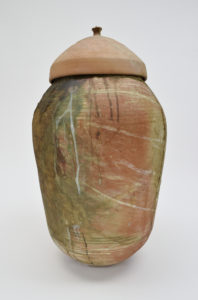Qumran Jar and Lid
Palestine, 100 BCE—100 CE
Pottery, jar: h. 24 x dia. 16 in.; lid: h. 8 x dia. 10 in.
Cincinnati Skirball Museum, gift of Jack and Audrey Skirball, a/869A-B
The Dead Sea Scrolls are literary remains of the members of a Jewish sect who lived at Qumran, on the western shore of the Dead Sea, from about 135 BCE to about 68 CE. A pious people living in communities of their own close to the desert, the members of this sect wrote and preserved the Dead Sea Scrolls, which contain several books and portions of books of the Hebrew Bible, biblical commentaries, fragments of the Apocrypha and Pseudepigrapha, as well as completely unknown books. The scrolls were discovered early in 1947 when a young Bedouin, searching for a lost goat, entered a cave in the cliffs south of Jericho. There he found jars, twenty-five to thirty inches tall, containing leather scrolls wrapped in linen cloth. Approximately fifty jars were found in the caves of Qumran. The scrolls inside the jars are remarkable because they are among the earliest known manuscripts of the Hebrew Bible, and they have enhanced the understanding of Judaism during the Second Temple period. They shed light on the diversity of Jewish thought and observance during this period, as well as describing in detail the local way of life and teachings of this ancient text.
This jar was found in Cave 1, the first cave where the Dead Sea Scrolls were discovered. This cave contained seven intact scrolls. The for of this jar and lid became the architectural inspiration for the Shrine of the Book Museum in Jerusalem, which houses most of the original Dead Sea Scrolls.
Publications:
Artistic Expressions of Faith in Judaism, Christianity, and Islam, ed. Abby S. Schwartz, 1997, p. 5.
Jason Kalman, Hebrew Union College and the Dead Sea Scrolls, Hebrew Union College Press, 2012.

